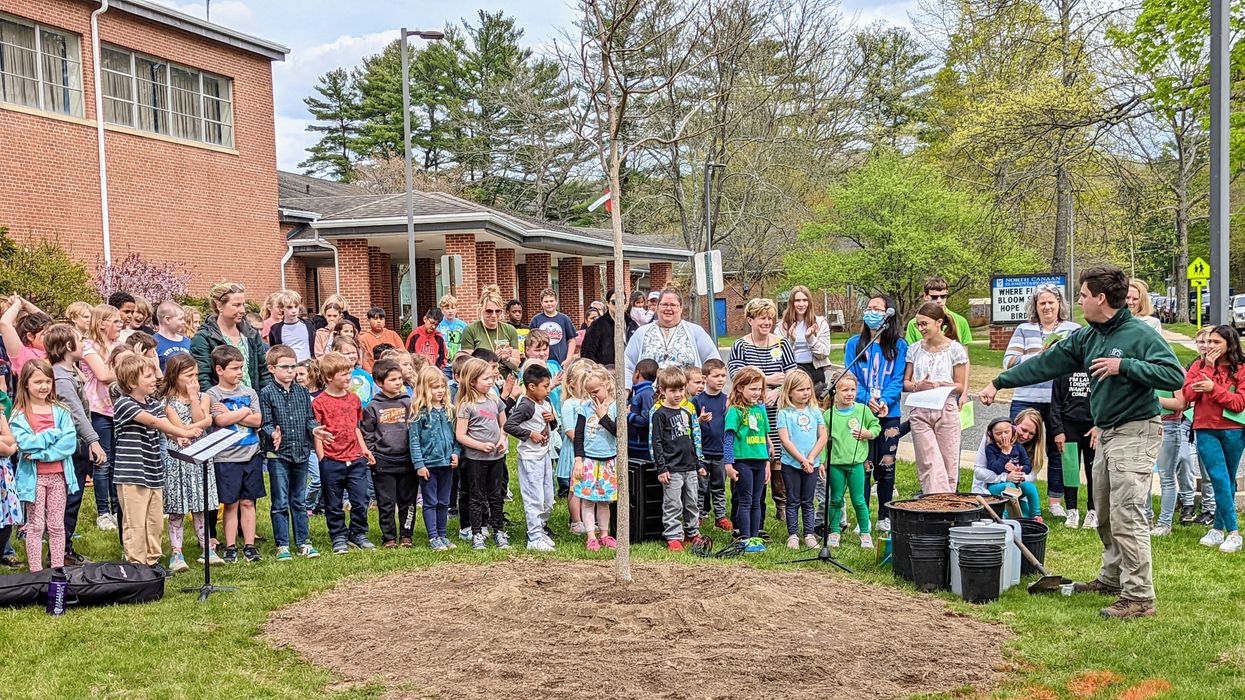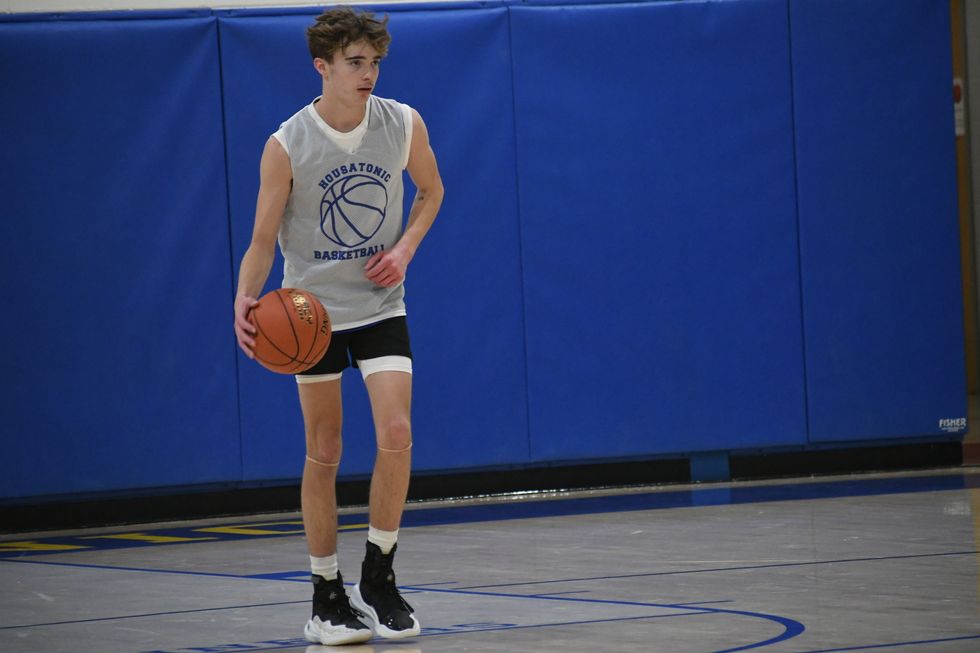North Canaan welcomed change, embraced tradition

Christian Allyn, right, led an informative tree planting at North Canaan Elementary School on Arbor Day. The students added a northern catalpa to the school’s arboretum.
Photo by Riley Klein

Christian Allyn, right, led an informative tree planting at North Canaan Elementary School on Arbor Day. The students added a northern catalpa to the school’s arboretum.
NORTH CANAAN — The times they are a-changing in North Canaan.
With a fresh selectmen administration, a nod from voters to permit cannabis licenses, and a range of new business development in town, the revitalization of North Canaan was in full swing in 2023.
The municipal election drew considerable interest last year with 58.5% of registered voters turning out to make their voices heard. Brian Ohler, former state representative (R-64), won the open seat of first selectman against Christian Allyn. Jesse Bunce joined the board and Craig Whiting was reelected to a fourth term as selectmen.
“We have our own vision now and it’s going to take a little bit to implement that. But I’m confident with Craig and Jesse we can work together and we can be the team that North Canaan needs,” said Ohler during the first meeting of the new board.
On voting day, North Canaan narrowly approved recreational cannabis sales in town. A 17-vote margin was confirmed by recount and has subsequently opened the door for prospective marijuana entrepreneurs in the Northwest Corner. A rough timeline from the Planning and Zoning Commission aimed for February 2024 as the target to have regulations in place.
The revitalization on Railroad Street continued last year, and neon lights from Colonial Theatre’s marquee once more brighten downtown North Canaan. The historic movie house had been shuttered since 1997 except for an extensive refurbishment and brief revival in the early 2000s.
Now the excitement is returning. In April, Lenore and Marc Mallett and David and Stacey Fiorillo, two Salisbury couples, purchased the old theater, rolled up their sleeves, and plotted a future designed to bring life and activity back to downtown Canaan.
Union Station’s lights are shining a bit brighter, too, since the November 2023 opening of the Art Bar & Cafe by owner Chris Tripler. The wine bar features local artists in its Community Gallery.
Art Bar & Cafe manager Melanie Teardo said the addition to downtown North Canaan brings “something unique to the area. Definitely nice to have a little bit of night life around here.”
She said it creates “a sense of community” among local artists. “You don’t have to be an expert painter to be a part of it.”
Ilse Coffee opened a cafe in the old location of Jim’s Garage on Railroad Street. The light-filled and airy space is a testament to the dedication of its founders, Rebecca Grossman and Lucas Smith. They transformed the old garage into a bright and cozy spot for coffee lovers, an open-concept space that showcases their entire production.
“This is kind of where the journey started,” Grossman said, “so it’s a very cool coming home.”
Eagle Scout candidate Dylan Deane completed the creation and installation of four directional signs across town. The high-quality blue road signs direct motorists to points of interest as they enter North Canaan.
“It went from paper to reality,” Scout Deane said as he thanked numerous sponsors that contributed to the project. “Sometimes I thought it would never happen.”
Despite the change, timeless town traditions persevered throughout the year. Students of North Canaan Elementary School (NCES) added a northern catalpa to their school’s arboretum on Arbor Day. For the 33rd year, NCES celebrated the annual tradition before a crowd of relatives and loved ones.
For the 59th time, Railroad Days rolled into Union Station for 10 days of summertime splendor. The celebration included a full menu of events ranging from train rides to bed racing and just about everything in between.
Led by Grand Marshal Charles Perotti, the Parade of Canaan marched through the center of town on July 15, showcasing 24 fire companies from across the region along with local businesses and organizations. Floats from Great Falls Brewery, William Perotti & Sons, United Ag & Turf, 711 Racing Team, and the Railway Express captivated crowds as they flowed down Main Street.
Some change in 2023 was met with resistance. A proposed 20-lot subdivision along the Housatonic River has sparked outcry from environmentalists seeking to conserve the Wild and Scenic River corridor.
“This proposal perplexes me and saddens me. To commit 20 houses to be built on Honey Hill river frontage would allow the developer to take private financial advantage of a public resource that the Housatonic River Commission worked to protect for 40 years,” said Tom Zetterstrom.
The public hearing on the subdivision application will continue in 2024.
The Salisbury Winter Sports Association (SWSA) will host its annual Junior Jump Camp, a two-day introduction to ski jumping, on Saturday and Sunday, Dec. 27 and 28, from 9 a.m. to 2 p.m. at Satre Hill in Salisbury.
The camp is open to children ages 7 and up and focuses on teaching the basics of ski jumping, with an emphasis on safety, balance and control, using SWSA’s smallest hill. No prior experience is required.
The cost is $50 per child and includes instruction and lunch on both days. For more information or to register, visit www.skireg.com/swsa-camp or email info@jumpfest.org
Jesse Bunce, first selectman of North Canaan.
LITCHFIELD — The Northwest Hills Council of Governments welcomed six newly elected municipal leaders Thursday, Dec. 11, at its first meeting following the 2025 municipal elections.
The council — a regional planning body representing 21 towns in northwest Connecticut — coordinates transportation, emergency planning, housing, economic development and other shared municipal services.
Barkhamsted First Selectman Meaghan Cook, Goshen First Selectman Seth Breakell, Kent First Selectman Eric Epstein, Norfolk First Selectman Henry Tirrell, North Canaan First Selectman Jesse Bunce and Torrington Mayor Molly Spino were each elected to their post in November.
They filled the seats of their predecessors on the COG, who were each given a toast of appreciation: Nick Lukiwsky (Barkhamsted), Todd Carusillo (Goshen), Marty Lindenmeyer (Kent), Matt Riiska (Norfolk), Brian Ohler (North Canaan) and Elinor Carbone (Torrington).
COG Executive Director Rob Phillips said the outgoing members were given a going away mug that read “You’re living the dream still.” Members voted to appoint Warren First Selectman Greg LaCava to fill a vacancy on the Council’s Executive Committee. COG members voted by paper ballot, and LaCava defeated Burlington First Selectman Doug Thompson for the vacant seat.
Ryan Segalla takes a fadeaway shot over a defender.
FALLS VILLAGE — Housatonic Valley Regional High School’s boys basketball team defeated Pine Plains High School 60-22 in a scrimmage Tuesday, Dec. 9. The non-league preseason game gave both sides an opportunity to run the court ahead of the 2025-26 varsity season.
HVRHS’s senior-heavy roster played with power and poise. The boys pulled ahead early and kept their foot on the gas through to the end.
By halftime the score was 33-8. Junior varsity players subbed in for the second half, but not before the starters got some in-game dunk practice. By the end Housatonic totaled 60 points to Pine Plains’ 22.

Nick Crodelle led the Mountaineers offensively with 13 points. Anthony Labbadia and Wyatt Bayer scored nine points each. Anthony Foley scored eight points. Owen Riemer and Ryan Segalla each scored seven points. Peyton Bushnell hit a three-pointer. Jaxon Visockis and Henry Berry each scored two points.
HVRHS begins Berkshire League competition on the road at Nonnewaug High School Tuesday, Dec. 16, with a 6 p.m. tip off.


Katie Moore delivers toys to the Stuff a Truck campaign held by the Kent Volunteer Fire Department last weekend. Donated toys are collected so that parents, who need some assistance, may provide their children with gifts this Christmas. Accepting the donation are elves Fran Goodsell and Karen Iannucci
KENT — Santa’s elves were toasty warm as they collected toys for the children of Kent.
Keeping with annual tradition, Fran Goodsell and Karen Iannucci manned the Stuff a Truck campaign sponsored by the Kent Volunteer Fire Department on Saturday, Dec. 6, and Sunday, Dec. 7. Sitting in front of a fire pit in the firehouse parking lot between donations from residents, they spoke of the incredible generosity displayed every season. That spirit of giving was clear from the piles of toys heaped on a table.
“This is always so gratifying,” said Goodsell, noting that certain businesses, including High Watch Recovery Center, Wilson’s, and Kent and South Kent schools needed a “shout out” for all they’ve done. She said South Kent School focuses on gifts for older children, which is a group that often is overlooked.
Unwrapped contributions are sought for children 1 to 15 years old who might otherwise find little or nothing from Santa, they said. The bounty will be set up at the Community House on Thursday, allowing parents to come and take what they want. If there are still items left, grandparents are invited to “shop.”
The atmosphere was festive Saturday, as a stuffed dog began barking a Christmas tune whenever someone walked in front of it. A large decked-out bear posted at the parking lot entrance reminded passersby of the event. Visiting children were able to get a close-up look at the fire truck and walk through the firehouse if they wished.
Goodsell and Iannucci were very grateful to those who donated wood for the fire pit. “And so many asked if they could bring us coffee or hot chocolate,” said Iannucci.
Goodsell said many who came talked about having grown children who were recipients of the gifts when their families were struggling. “They are so glad to be able to give back,” she said.